Click on the article title below to be taken directly to the article. After you’re done reading the article, click “Back to Top” at the bottom to be brought back to the Table of Contents.
Table of Contents
- Leadership Development, Policy Advocacy, Long Range Ag Aviation Industry Planning: All in a Week’s Work at NAAA/NAAREF DC-Area Meetings Last Week
- NAAA Survey to Assess Health & Life Insurance Needs of Industry; Deadline Feb. 26
- Last Chance to Attend 2023-2024 PAASS!
- Be On the Lookout and Please Complete FAA’s GA Survey – Data Collection for 2023 is Now Underway
- Emergency AD Issued for PT6A-67AG and -67F Engines
- NAAA Endorses and Encourages Ag Aircraft GPS Data Collection Effort Protecting Manned Ag Aircraft from Drones
Leadership Development, Policy Advocacy, Long Range Ag Aviation Industry Planning: All in a Week’s Work at NAAA/NAAREF DC-Area Meetings Last Week
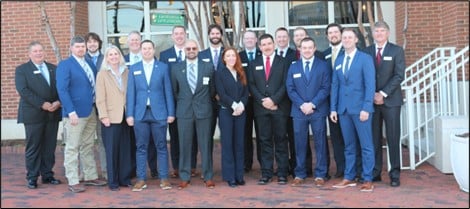
The NAAA Syngenta Leadership Training Program (LTP) and the boards and committees of the National Agricultural Aviation Association (NAAA) and the National Agricultural Aviation Research and Education Foundation (NAAREF) met in our national capital area region from February 13-17 to accomplish a multitude of benefits for the agricultural aviation industry. The meetings were led by 2024 NAAA President Ray Newcomb of New Hampshire and on the NAAREF side, President Perry Hofer from South Dakota.
Leadership Training Program (LTP) and Policy Advocacy
This was the 28th LTP class. The Syngenta program has been providing training in communications, media training, policy advocacy and personality trait identification to up-and-coming agricultural aviation leaders since 1995, including 14 new graduates to the program who participated last week. These annual February meetings in the Washington, DC area enable board, staff and LTP participants to visit federal lawmakers’ offices to advocate for national policies ensuring safe low-altitude aviation policies and pesticide and tax policies that are not unnecessarily burdensome to the industry. Dozens of these meetings were held last week.
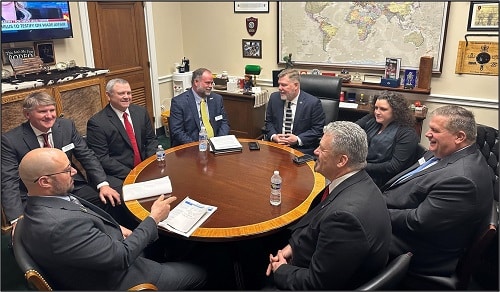
AgAv PAC Breakfast
NAAA hosted a breakfast fundraiser for its political action committee—AgAv PAC—during its capital area board meeting and was joined at the event by U.S. Representative David Valadao (R-CA). Valadao has been a long-time supporter of federal USDA research developing aerial application technologies. He spoke about the efforts to keep the government funded without shutdown, particularly for meaningful farm policy programs; concerns with the U.S.’ fiscal reputation with massively growing federal debt, and optimism that the 2024 elections may result in a shift in majority in the Senate. The AgAv PAC is an important NAAA program that supports the campaigns of individuals running for federally elected office who are supportive of the agricultural aviation industry.
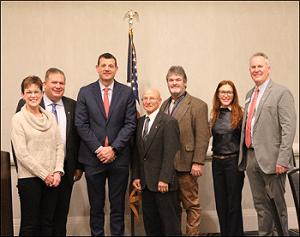
EPA Report
Rod Snyder, the senior agricultural advisor to EPA Administrator Michael Regan, addressed attendees the morning of February 16th and discussed further developments by the agency to balance protections of threatened and endangered species exposure to pesticides with agriculture’s needs to protect their crops. Numerous lawsuits by environmental activist groups have led the EPA to issue herbicide and rodenticide protections to vulnerable species in the past year, with further fungicide and insecticide protections forthcoming. Snyder announced two recently issued EPA policies to refine the maps of endangered and threatened species habitats where pesticide use limitation areas would be located. Current EPA Bulletin Live! Two (BLT) endangered species maps have been criticized for being overly broad in the areas they target. Snyder discussed efforts by the agency to refine the maps, including via an effort with the University of Georgia, to ensure protections but mitigate burdens to pesticide users protecting cropland. Snyder also mentioned a memorandum of understanding between the EPA and the USDA’s Natural Resources Conservation Service (NRCS) to provide more pesticide label flexibility for applicators participating in NRCS programs that protect endangered species and their habitat. One endangered species protection presently being considered via the BLT process included requiring filter strips between cropland and habitat. NAAA raised the question of what party is responsible for ensuring the presence of a filter strip at the time of the application, the applicator, or the farmer (if the farmer has contracted out with a commercial applicator). Snyder stated that the EPA is still determining who would be the culpable party in such a situation.
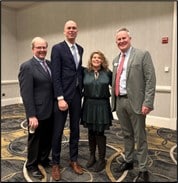
CEO Report
After the PAC breakfast and EPA presentation, NAAA CEO Andrew Moore provided an overview of recent national agricultural aviation events and NAAA’s involvement in positively influencing those events to benefit the industry. He reiterated that NAAA’s primary function is to advocate for pesticide language allowing aerial application use without unnecessarily burdensome restrictions. NAAA is developing survey questions for a comprehensive study profiling the agricultural aviation industry for the 2024 season, including questions on aerial pesticide use. This data along with urging the EPA to use updated atmospheric modeling formulations, such as Tier 3 of the AGDISP model, results in more real world, accurate assumptions of aerially applied movement of pesticides and any possible risks associated with them, preventing misguided label restrictions for aerial applications. Since 2017, NAAA has commented on 270+ EPA pesticide active ingredient and pesticide regulatory policies. This year EPA is expected to release its endangered species insecticide and fungicide strategy and draft reregistrations for neonics and acephate, amongst others.
Moore also touched on efforts to modernize the computer coding of the AGDISP atmospheric model to ultimately steer away from a one-size fits all risk assessment and instead having more realistic, site-specific risk assessments conducted in real time through updating the model. Currently, $50,000 of a total of $250,000 over five years has been received from the Centers for Disease Control to recode the model. A total of $500,000 will be necessary to complete the recoding.
Moore touched on low-altitude airspace safety issues and announced, due to effective lobbying on NAAA’s behalf, the U.S. Senate’s recent markup of their FAA Reauthorization included language in its drone beyond visual line of site operations (BVLOS) section that the FAA “ensure the safe coexistence of UAS with manned aircraft operating in the national airspace system.” This language parrots similar language in the House’s enacted version and is an important victory as the FAA has stated it hopes to release a draft UAS BVLOS rulemaking as early as August of 2024. NAAA, along with nearly all national general aviation organizations and airline pilot associations, have implored that the FAA proceed with caution when promulgating BVLOS policy and to ensure that UAS provide right-of-way to crewed aircraft and equip with failsafe detect and avoid technology. Also included in the Senate version of the FAA Reauthorization is language urging the FAA to complete the tower-marking rule for rural towers between 50 and 200 feet or report in detail on an annual basis as to why not. NAAA continues to urge new FAA Administrator Whittaker to promulgate the tower marking/logging rule.
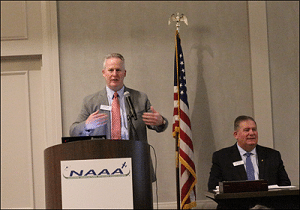
Moore also stated that the Federal Motor Carrier Safety Administration has informed NAAA that the proposed rule to allow states to allow CDL licensees to transport 1,000 gallons or fewer of Jet A without a HazMat endorsement should be released for comment on or before October of 2024.
Moore also stated that the current Farm Bill is set to expire by September 2024 unless reauthorized. Both the House and Senate are working on new Farm Bill legislation, but due to the cost of the legislation and small majorities in Congress, that will be a challenge. The current federal debt at $34 trillion has increased well over 50% since the last Farm Bill ($21 trillion in 2018), when $26.3 billion of agricultural and nutrition spending was cut. Regardless of the challenges, NAAA is pushing Congress to include a regulatory relief title in the bill that would exempt pesticide applicators from the NPDES pesticide general permit, and that would defer to the states and federal government’s scientific and regulatory expertise to develop and enforce pesticide law, not the 80,000 local government jurisdictions throughout the country that lack the resources. NAAA is also pursuing language supportive of the USDA’s Aerial Application Technology Unit within the Farm Bill and to ensure that subsidies for rural broadband towers be made on the condition that the towers are properly marked and logged per the 2018 FAA Reauthorization.
Moore then shifted to communications issues and reported on the first of four Farm Journal one-page articles and half-page ads in the Scoop magazine was published this month as a result of NAAA’s recent agreement with the publisher. The Scoop reaches 20,000 national retailers and crop consultants and the ag aviation content may also be shared on AgWeb (200,000 farmers nationwide), Top Producer (100,000 farmers that grow over 1,000 acres nationwide) and other Farm Journal publications. He also discussed that NAAA will again be exhibiting on Ag on the Mall this May, organized by the Association of Equipment Manufacturers. NAAA exhibited in 2022 with a helicopter that will again be on display thanks to Helicopter Applicators Incorporated in Gettysburg, PA. The event was densely attended by agricultural press and the general media, as well as senior federal policymakers, and lawmakers in addition to a public audience of approximately 270,000.
Moore then shifted to industry issues and stated that a new drone application pilot association had been formed known as the Unmanned Pilots Association for Safety & Standards, or U.PASS. The organization’s website states that its services include third party safety certification and a 137 step-by-step guide. He also stated that NAAA accepted an invitation to speak at the 2nd Spray Drone End User Conference later this month to inform drone application users about NAAA’s pesticide registration advocacy, CEU qualifying education programs, investment in obtaining federal aerial application technology research, and networking, amongst other services. NAAA also received an invitation to attend the Brazilian aerial application trade show, SINDAG, later this summer to discuss the possibility of establishing an international agricultural aviation association for knowledge sharing purposes.
Next discussed were ag aviation accidents. A few weeks ago, the FAA released the results of its General Aviation Activity survey from 2022 and it showed that the number of accidents in the ag aviation industry that year was 51 with nine fatal accidents out of a total of 831,999 hours flown. This resulted in 6.13 accidents per 100,000 hours flown, and it further increased the percentage reduction of accidents per 100,000 hours since the PAASS program hit the state in 1999 to a 26.60% decrease in accidents between 1999-2022 when compared to 1993-1998 figures. This matches a 26% reduction in drift incidents since PAASS. This is a remarkable figure when considering that fewer than half, or 47% of ag pilots attended PAASS prior to 2020.
Moore then discussed the Certified Professional Aerial Applicator Safety Steward, or C-PAASS designation, for 2024. C-PAASS now includes the availability of an online curriculum that a C-PAASS professional must review and be tested upon for knowledge of the effects of droplet size to the spray pattern and safely operating in a wire environment. These online educational requirements must be satisfactorily met in addition to 2024 NAAA and state/regional ag aviation association membership; PAASS attendance the past three seasons; and biennial Operation S.A.F.E. participation.
It was also announced that the Agricultural Airman Certification Guidelines, a comprehensive manual in which to test proficiency for crewed agricultural aircraft operations, will soon be made available to NAAA members and should complete safety requirements set out by the NTSB back in 2014 for NAAA and the agricultural aviation industry to address to mitigate 14 CFR Part 137 safety risks.
Moore then discussed Ag Aviation Expo results and prospects. In 2023, the convention in Palm Springs netted $651,775 in overall income with 1,276 in attendance. This compared to netting $819,801 in overall income in Knoxville in 2022 with 1,573 attendees. The 2024 show will be in Fort Worth, Texas and excitement levels are very high for the show. The Kickoff Breakfast speaker will be Australian Kevin Humphreys, a 20-year military veteran that flew Black Hawk and Chinook helicopters for the Australian Army in East Timor, Iraq, Afghanistan and many other high-intensity theaters. He suffered and overcame post-traumatic stress disorder (PTSD), depression and anxiety and will share the PTSD triggers he experienced and how he addressed his mental state and transformed his life. The convention’s general session speakers will be Noah Parr, an H2A farm labor contract with recommendations on how to legally employee out of country ag aviation laborers. Geffrey Anderson with the Texas law firm of Anderson Riddle LLP will hold a mock drift trial to demonstrate how to be prepared to avoid drift claims or how to combat them if wrongfully accused. Moore then stated that the 2025 and 2018 Ag Aviation Expo will be held in Reno, Nevada, Savannah in 2026, and Oklahoma City in 2027.
NAAA membership numbers were then reported. At year end of 2023, NAAA had 1,700 members (541 operators and 531 pilots). This compared to 1,826 total members as of the end of 2022 (573 operators and 566 pilots). This is a 7% drop in members between 2022 and 2023. There are 1,560 U.S. aerial application operators and 2,028 U.S. non-operator ag pilots in the U.S. Renewals for 2024 show that there were 1,142 NAAA members as of the end of January (418 operators and 308 pilots. This compares to 1,129 NAAA members as of the end of January 2023 (423 operators and 323 pilots). NAAA’s association management service, Atria, is presently calling non-renewing members to join for 2024. NAAA will also send non-renewing member lists to the board representatives for them to contact and request to re-join.
Moore also discussed the recent crafting by the president, and past and current treasurer of the 2024-2025 NAAA budget. The fiscal year begins on July 1st. The draft budget overestimated expenses and underestimated revenues and is projected to have a ($116,568) deficit. This includes $42,000 worth of depreciation, a $13,000 increase in general office funding for building repairs to replace leaking and poorly insulated windows. It also, to be fiscally conservative, does not take into account likely higher convention attendance numbers due to being held in Texas, the largest state in terms of aerial application businesses in the country; and membership numbers that could go higher due to excitement about an NAAA health care program for its members. For fiscal year 2022-2023 a deficit was projected of ($50,679), yet at the actual conclusion of the fiscal year a $158,743 surplus was achieved. Similarly, in fiscal year 2021-2022, a deficit was projected of ($115,183.00), yet at the actual conclusion of the year a surplus of $354,109.11 was achieved.
Moore, before concluding, stated that there is a substantial list of projects that the association staff must address on a perennial basis including the following: FIFRA pesticide policy and aerial label re-registrations; securing USDA-ARS aerial application funding; responding to FAA airworthiness directives and other aviation policy rulemaking and related policy issues affecting the agricultural aviation industry; organizing the Ag Aviation Expo and spring and fall board meetings; writing and researching weekly eNewsletters, website updates, social media posts; publishing three Agricultural Aviation magazine editions and an annual membership directory; writing four Farm Journal articles and a slew of press releases for the ag, aviation and general media; development of original PAASS program content, weekly Fly Safe messages and Operation S.A.F.E. clinics; membership marketing; writing AgAir Update columns; scholarship and awards management; leadership training program organization; daily board and membership inquiries and case work; accident tracking and analysis; and much more.
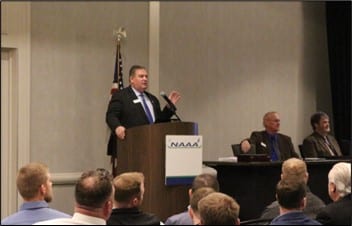
Moore mentioned that in addition to the above, this year there are additional projects to complete including the following: Ag on the Mall; C-PAASS educational module(s); FAA Reauthorization advocacy; Farm Bill advocacy; commenting on FAA BVLOS NPRM; conducting a 2024 Ag Aviation Industry Survey; implement health/disability insurance for members; install new database; comment on FMCSA proposed regulation to allow states to allow transportation of up to 1,000 gallons of Jet A without a HazMat endorsement; EPA endangered species comments on insecticide, fungicide policy; updated coding of AGDISP and develop site specific risk assessment; develop Flight Risk Assessment Tool; and more. Because of the abundance of projects needing attention, Moore counseled that the board look to rescind projects that don’t follow the policy advocacy; promotion of positive public relations; networking; and professional, ethics-focused education and safety programming that the association is charged with per its Articles of Incorporation and Bylaws.
Moore then concluded his presentation. Committees were held for the next day and a half, and the board reconvened on Saturday, February 17th.
Following are some of the key motions and activities discussed and agreed to by the board to advance the association and U.S. agricultural aviation industry:
Allied & Convention Committees: The committee discussed the 2024 Ag Aviation Expo in Fort Worth, Texas, Nov. 18-21, which will take place the full week before Thanksgiving. The Excellence in Ag Aviation Banquet dinner will take place on Wednesday now, the final day of the convention. The past few years NAAA has had attrition contract penalties because the room blocks were not filled. The committees urged to spread the word to attendees and exhibitors who block several sleeping rooms early on for the Ag Aviation Expo to cancel the reservations a couple of months out if rooms will not be used allowing others to reserve them and keep the NAAA from paying attrition fees from attendees and exhibitors that cancel rooms a few days before arriving.
Awards: The committee established a deadline for the 2024 NAAA Awards nomination of August 5, 2024. Award nominations may be made online.
Budget & Finance: The committee reported that the financial status of NAAA looks promising with just shy of half a million in net income this current fiscal year that expires June 30th, and over $5 million in assets. A Fiscal Year 2024-2025 budget with a deficit of $116,568 was approved.
Communications & Public Relations: In addition to what was reported during the CEO report, the committee stated that the NAAA eNewsletter will have a new look this year as the old software is sunsetting and a new company with a new format must be identified.
Government Relations: The committee discussed the Fair Labor Standards Act (FLSA) and a situation where a U.S. operator was pursued by the Department of Labor (DOL) to pay overtime to an ag pilot, even though these company’s pilots are employed as full-time employees with benefits. Ultimately, the DOL tabled pursuing the matter. The spring 2024 issue of Agricultural Aviation magazine includes an article about this subject. For now, the committee tabled advocating that the DOL consider aerial crop spraying as an enforceable non-exempt occupation, but that will change if the DOL further pursues this issue to the detriment of aerial application operators.
Chlorpyrifos use allowances due to a recent court decision was discussed. EPA will begin moving forward working on an amended proposed interim decision (PID) that limits chlorpyrifos to 11 crops: alfalfa, apple, asparagus, cherry (tart), citrus, cotton, peach, soybean, strawberry, sugar beet, spring wheat, and winter wheat. NAAA is working to ensure aerial application is on the label for all those crops and is in communication with EPA, grower groups and registrants to see if expanding the list of allowable crops beyond the 11 is possible. EPA anticipates releasing the amended chlorpyrifos PID. Commodity associations will play a central role to see if their crop may be included for chlorpyrifos use via aerial application. EPA assigns greater risk to aerial applicators applying chlorpyrifos because an aircraft treats a greater number of acres per day, hence loaders, according to the EPA have a higher exposure risk. It was discussed by the committee that EPA base the exposure over a longer timeline and not on a per day basis.
The committee also discussed H2A labor and the industry’s interest in expanding the allowance of migrant laborers to work at aerial application businesses, including public airports. Noah Parr with USA Farm Labor, an expert on the subject, will discuss this program at the 2024 Ag Aviation Expo General Session An ad hoc committee was formed to further research and discuss this issue.
Insurance: The committee discussed insurance articles for the Agricultural Aviation magazine, including how UAVs are insured, and an article quizzing pilots about whether they are insured properly. The 2024 Ag Aviation Expo will feature an insurance mock trial organized by Geffrey Anderson and Shannon Dugan of Anderson & Riddle, LLP. Rebecca Burns, NAAA Insurance Division board representative is asking for volunteers to be part of the mock trial.
Long Range Planning Committee: Drone issues were discussed, including that Andrew Moore (NAAA CEO) will attend and present at a spray drone users conference next week. Dating back to 2013, drones and the fear of the unknown, such as the safety of ag pilots, etc. have been a concern for crewed ag aviators. Now, things are changing, and relationships are being built between manned and unmanned aerial pesticide applicators and more and more operations are operating hybrid services, making sense to have NAAA serve as an umbrella group for both organizations.
Also discussed was talk about other countries establishing an international trade association for information sharing purposes. The committee passed a motion that NAAA send a representative to SINDAG—the Brazilian’s national ag aviation association’s annual convention—to have those conversations with the delegates of other country’s associations in attendance.
The committee also discussed the perception amongst some that NAAA is a ‘good ole’ boys club.’ PAASS presenters and officers attending state/regional associations will be asked to introduce themselves to people in the local jurisdictions to be more welcoming.
Membership: NAAA will be implementing an entirely new membership database in March to make it easier to log into the member’s only account, register for educational programming, etc.
The committee also discussed the health and life insurance policy in which NAAA is working to provide more affordable insurance to its members. Everyone, pilots, operators, allied, member and non-member are urged to take a survey gauging your insurance industry’s needs here.
The committee is also challenging each state board member to increase NAAA members in their state by 10%. If membership increases that amount compared to 2023 membership numbers, a prize for the person who increases membership from their state by the greatest percentage will be able to have their state flag, or flag of their choice, to be cut into CEO Andrew D. Moore’s hair.

Museum: The National Agricultural Aviation Museum and Hall of Fame will officially and forever house the Snow S-2A, which is expected to be delivered to the museum later this year after the aircraft visits Olney, Texas this spring for Air Tractor’s 50th anniversary.
The National Agricultural Aviation Museum Walkway where the names of all deceased pilots will appear on walkway bricks leading to the museum is in the design stage. Graham Lavender has all names of falling ag pilots dating back to 1984.
Precision Ag: Guest Amy Sullivan, executive secretary of the Association of American Pest Control Officials attended this meeting and the NAAREF Board meeting and stated that academic and government grant money exists to potentially update the national aerial applicator manual, particularly to consider an unmanned aircraft portion to the manual for training and testing purposes. Steps planned presently include establishing a group of aerial applicators to answer charge questions of whether the manuals need updating, what are new best management practices, equipment changes that have taken place, what information is missing, etc. NAAA/NAAREF will follow up confirming their interests to be part of this project to Ms. Sullivan.
In addition, grants are available to educate state pesticide control officials about ag aviation educational materials and operations. NAAA/NAAREF will also follow up with Ms. Sullivan about this opportunity to educate the control officials about PAASS, Operation S.A.F.E. and C-PAASS educational materials to further spread their use to the agricultural aviation industry.
Safety and Federal Aviation Regulations: The committee reported that there had been one non-fatal accident in 2024, to date.
There was a discussion to identify and promote a common radio frequency for agricultural aviation to encourage communication and help prevent mid-air collisions. FAA is going to investigate using 122.925 for ag aircraft communications.
Remote identification is in effect for all new UAS; and older UAS must be retrofitted with it and must be fully compliant by March 16.
Support: The Athena Project curriculum for the 2024-2025 program was announced. It will be titled “What’s your game plan? How to lead your team to victory this season.” The program will discuss what can be done in the office in advance during the off season to prepare all employees for the busy season to ease stress when activity heats up. It will also discuss the development of plans to follow in the event of emergency flare ups at the operation. The program will discuss scenarios and have interactive discussions.
The scholarship topic for 2024 is “What are the biggest obstacles to the ag aviation industry in your area? Discuss how they could be overcome.” The information and application form here, and the deadline is Sept. 15.
NAAREF: The NAAREF Board discussed the success of the 2023-2024 PAASS Program and a makeup PAASS program will be provided on March 12th at a fee of $900 for anyone who couldn’t make it in person to a state/regional association.
NAAREF Board members also discussed C-PAASS and the two courses that are currently in the Education Center, and pricing for members and non-members for courses in the Education Center (see https://education.agaviation.org/cpaass-info). One course is on avoiding wire strike accidents and the second is on the basics of spray droplet size. These courses will be available for free to NAAA members. For non-members, the courses will cost $100 per hour per course. It was determined that any operator or pilot NAAA member who within the past year attends the Flying in the Wire and Obstruction Environment Course from either a state sponsored course or at the Ag Aviation Expo, will fulfill one half of the Education Center requirements for 2024 C-PAASS certification. For 2024, C-PAASS certification requires PAASS attendance for the past three years, participation in Operation S.A.F.E. once in the past two years, completion of both courses on the NAAA Education Center, and membership in both NAAA and a state or regional ag aviation association.
State Reports: Mississippi: Glenn Holloway (Vice President) provided an update on state tower legislation that will soon be sent to the state’s governor for signature. The legislation requires that when a MET tower company applies for a permit, the company is required to contact the Mississippi Agricultural Aviation Association executive director with the geospatial location of the tower for the purpose of it being shared with the association’s membership, so they are aware of the new tower(s)’ location.
Illinois’ board member, Don Younglove, presented NAAREF with a $5,000 donation and North Dakota’s board member, Toby McPherson, presented NAAREF with a $2,000 donation.

Michigan’s board member, Tim Swanson, shared his experiences of working to get everyone in his state to also be a member of NAAA. Currently, the state of Michigan only has two state members that are not also NAAA members. He suggests calling and visiting with non-members to share the NAAA benefits.
All in all, the 2024 NAAA/NAAREF Board meeting and associated events were a tremendous success and proof that substantive business benefiting everyone in the U.S. aerial application industry was conducted. Moreover, evidence was heir apparent that NAAA is an inclusive organization for all in the aerial application industry to feel welcome in its large and open tent.
Back to top
NAAA Survey to Assess Health & Life Insurance Needs of Industry; Deadline Feb. 26
NAAA works continuously to identify opportunities that enhance the benefits available to our members. Over the past few years, we’ve received requests for access to more affordable, quality health and life insurance plans than what the aerial application operators and ag pilots in our industry may currently have access to. Therefore, NAAA is currently exploring the possibility of offering health and life insurance benefits for our membership. Your input is helpful in identifying these opportunities.

Take this short survey to help us assess the potential of this benefit and your interest. The survey will take less than five minutes to complete. Results will be used only to gauge the interest in health benefits and other insurance and financial solutions to members, and will not be shared outside the organization or used for selling purposes.
NAAA is exploring a partnership with Decisely, an online, integrated benefits and HR solutions company that sources and administers benefits including medical, vision, dental, life insurance, and more. This partnership can deliver health solutions, pricing, and support options to provide more cost-effective solutions for the aerial application industry.
Please participate in this important survey no later than February 26, 2024 so we get a true picture of insurance needs for our membership. If you have any questions, please contact Deana Kissinger by email or phone at (202) 546-5722.
Take the survey by clicking here.
Last Chance to Attend 2023-2024 PAASS!

If you missed this year’s PAASS Program, you have one more chance. There will be a Zoom PAASS Program on Tuesday, March 12, from 9 a.m. to 1:30 p.m. CDT (10 a.m.–2:30 p.m. EDT). The cost is $900 per person. Attend PAASS — The life you save might be your own. Click Here to Register
Back to top
Be On the Lookout and Please Complete FAA’s GA Survey – Data Collection for 2023 is Now Underway
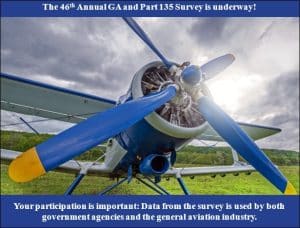
The FAA’s 46th annual General Aviation and Part 135 Activity Survey (GA Survey) is now officially underway. The survey is for collecting aviation activity for the calendar year 2023. The GA Survey is the only source of information available that provides reliable data on the GA fleet, including number of aircraft and hours flown. The data is used by the FAA, other government agencies, and the aviation industry for a variety of things, including assessing safety and understanding the economic impact of aviation.
Note that not everyone will be invited to participate – the survey reaches about 30% of GA aviators every year. If you are selected to participate in the GA Survey, you will receive an email or postcard invitation asking you to complete the survey online. For those who chose to not complete the survey online, a mail survey is sent which includes a postage-paid return envelope. The information is confidential and will only be used for statistical purposes and will not be published or released in any form that would reveal an individual participant. It only takes 10-15 minutes to complete the survey. You may be asked to participate two or more years in a row. If you are contacted, please respond to the survey even if you did not fly your aircraft during 2022, sold it, or if the aircraft was damaged. If you own three of more aircraft, there is an abbreviated survey form you can use instead of needing to complete a survey for each aircraft.
The GA Survey is especially critical to the agricultural aviation industry. NAAA uses the results of the GA Survey, in conjunction with NTSB accident numbers, to calculate an overall accident rate and a fatal accident rate for Part 137 operations. This allows NAAA to track and document the safety of the agricultural aviation industry and provide evidence to the FAA and NTSB that PAASS and other safety programs are working to reduce Part 137 accidents.
If you have questions, please contact Tetra Tech, the independent research firm that conducts the GA Survey for the FAA, toll-free at 1-800-826-1797 or by email at infoaviationsurvey@tetratech.com. Results from prior surveys can be found here.
Back to top
Emergency AD Issued for PT6A-67AG and -67F Engines
On February 16, the FAA issued an Emergency Airworthiness Directive (AD 2024-04-51) for Pratt & Whitney Canada (P&WC) Model PT6A-67AG and PT6A-67F engines (among other dashes not in ag use). This AD was prompted by reports of contained failures of second-stage power turbine (PT2) blades. The root cause has not been determined, however, all affected power turbine modules contained PT2 blades with part number 3056693-01 and with 25 hours or less of accumulated flight time since new.
This AD directs immediate compliance with Transport Canada Emergency AD CF-2024-05, which mandates removal of affected blades prior to next flight. Critically, affected PT2 blades are defined as those identified in the P&WC Alert Service Bulletin (ASB) PT6A-72-A14574, and have accumulated less than 50 hours flight time since new, or since shop visit or since second-stage power turbine repair. Thus, if your PT2 blades have accumulated more than 50 hours flight time, they are not considered affected blades.
This Emergency AD is intended to prevent the failure of PT2 blades. This condition, if not addressed, could result in engine power loss or engine in-flight shut down, resulting in consequent emergency landing or reduced control of the airplane.
Back to top
NAAA Endorses and Encourages Ag Aircraft GPS Data Collection Effort Protecting Manned Ag Aircraft from Drones
As the Federal Aviation Administration (FAA) marches in lockstep with some corporate interests in the uncrewed aircraft systems (UAS) space, it is becoming clear that green lighting and expanding UAS beyond visual line of site (BVLOS) operations may be being prioritized over safety.
First proposed in the 2022 BVLOS ARC Report, and later put out for public comment in 2023, the FAA is considering designating “shielded” areas wherein UAS would have the right-of-way over crewed aircraft. These areas are defined as the airspace within 100 feet vertically or laterally of an obstacle or critical infrastructure, such as power lines. According to the ARC Report this is based on “the limited likelihood of crewed aircraft operations in [these] areas.”
The current reality is that some of these UAS interests (think BNSF Railway, Google, Amazon), and in some cases the FAA, do not have a solid understanding of where and how we operate. It falls now to us, as an industry, to inform future rulemaking of the unique nature of aerial application operations. Using a data-driven approach, we can demonstrate our utilization of the low-altitude airspace and expose the safety threat presented by UAS not giving the right-of-way to crewed aircraft within it.
To this end, NAAA has a longstanding partnership with Mississippi State University (MSU) to collect GPS data logs donated by its members. Since the project’s inception in 2017, the data collected and analysis performed by MSU has fueled NAAA’s efforts in representing the safety interests of aerial applicators to regulators.
If you have donated logs in the past, Thank You.
If you have logs which you have not yet donated, please consider it. The data you provide can help shape policy on a national level and save lives. As a reminder, any data you submit is stripped of any personally identifiable information prior to inclusion in the larger dataset.
There are two options to submit your logs to MSU:
- Request a secure upload link for data uploads. Email Madison Dixon, Associate Director, MSU Agricultural Autonomy Institute
- Mail a flash drive or other storage device to the address below (The device will be immediately mailed back once data is received if a return address is provided):
Mail To: Attn: Madison Dixon
MSU Agricultural Autonomy Institute
Pace Seed Technology Building
Mailstop #9812
650 Stone Blvd.
Mississippi State, MS 39762

